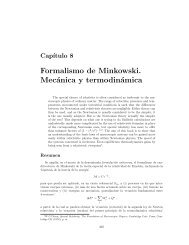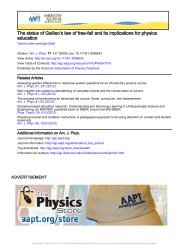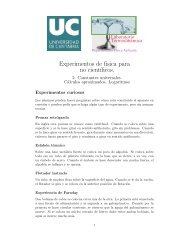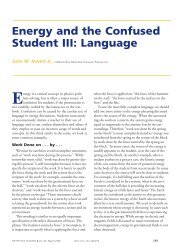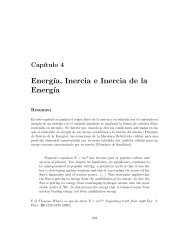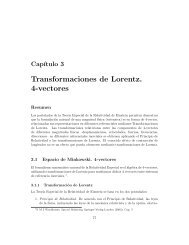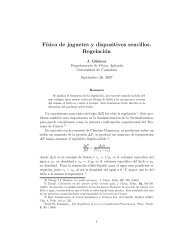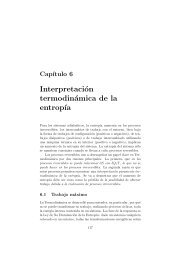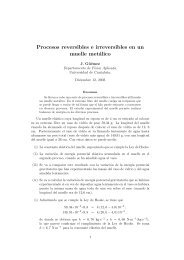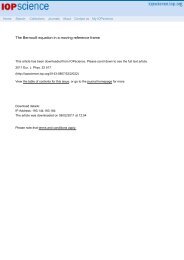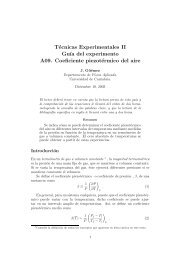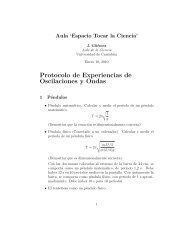Special Relativity in Week One: 1) The Principle of ... - Loreto-Unican
Special Relativity in Week One: 1) The Principle of ... - Loreto-Unican
Special Relativity in Week One: 1) The Principle of ... - Loreto-Unican
Create successful ePaper yourself
Turn your PDF publications into a flip-book with our unique Google optimized e-Paper software.
went up <strong>in</strong> the air over Boston, the Earth turned for threehours under the plane, and then the plane came back down <strong>in</strong>San Francisco. It was the Earth that moved, not the plane.Def<strong>in</strong>ition <strong>of</strong> the pr<strong>in</strong>ciple <strong>of</strong> relativity<strong>The</strong> stage is now set for a more precise def<strong>in</strong>ition <strong>of</strong> thepr<strong>in</strong>ciple <strong>of</strong> relativity. Imag<strong>in</strong>e that you are <strong>in</strong> a capsule andyou may have any equipment you want <strong>in</strong>side the capsule. <strong>The</strong>pr<strong>in</strong>ciple <strong>of</strong> relativity states that:<strong>The</strong>re is no experiment that you can performthat will allow you to determ<strong>in</strong>e that thecapsule is mov<strong>in</strong>g with uniform motion.We po<strong>in</strong>t out that our classroom is such a capsule. Due tothe rotation <strong>of</strong> the Earth, the motion <strong>of</strong> the Earth about theSun, the fact that the Sun is carried around by rotation <strong>of</strong>the Milky Way galaxy, and then there is the expansion <strong>of</strong> theuniverse, all these contribute to the motion <strong>of</strong> our classroom.But only the rotation <strong>of</strong> the Earth, which carries us around<strong>in</strong> a circle every 24 hours, has been directly observed. Whenyou are mov<strong>in</strong>g <strong>in</strong> a circle, you are not mov<strong>in</strong>g <strong>in</strong> a straightl<strong>in</strong>e. This slight deviation from uniform motion can bedetected with a Foucault pendulum.Speed <strong>of</strong> waves<strong>The</strong>re is one experiment that was expected to allow us todetect uniform motion. That experiment <strong>in</strong>volved the measurement<strong>of</strong> the speed <strong>of</strong> a light wave.To illustrate why such an experiment might be important,we start with an analogous experiment that is easier to observe.It is the measurement <strong>of</strong> the speed <strong>of</strong> a compressionalpulse on a stretched Sl<strong>in</strong>ky. Figure 2 is a photograph <strong>of</strong> astretched Sl<strong>in</strong>ky suspended from a steel pipe. <strong>The</strong>re is a support<strong>in</strong>gthread from the pipe down to every fourth coil <strong>of</strong> theSl<strong>in</strong>ky.If you pull back on one end <strong>of</strong> the Sl<strong>in</strong>ky and let go, you geta compressional pulse like the one shown <strong>in</strong> Fig. 3, that travelsdown the Sl<strong>in</strong>ky, reflects at the far end, and returns. Althoughwe had demonstrated these Sl<strong>in</strong>ky pulses for many years, onlyrecently did we do a careful analysis <strong>of</strong> the speed v pulse <strong>of</strong> acompressional pulse. <strong>The</strong> result was v pulse= KL / µ , where Kis the Hooke’s law spr<strong>in</strong>g constant, L the length <strong>of</strong> the Sl<strong>in</strong>ky,and m its mass per unit length. 3,4A phenomenon observed by David Keeports 5 is that thetime it takes for the pulse to travel down the spr<strong>in</strong>g and comeback does not depend on how much you stretch the spr<strong>in</strong>g. Tosee why, write the mass per unit length as m = m/L, where m isthe mass <strong>of</strong> the spr<strong>in</strong>g. <strong>The</strong>n our formula for v pulse becomes2vpulse = KL = KL = LK .m / L m m<strong>The</strong> time T it takes the pulse to go down and back, a distance2L, is T = 2L/v pulse . <strong>The</strong> factors <strong>of</strong> L cancel, with the resultthat T should not depend on L. Figure 4 shows our test <strong>of</strong> thisfeature <strong>of</strong> the pulse speed formula. We tripled the length <strong>of</strong>the Sl<strong>in</strong>ky from 83 cm to 260 cm, and the time the pulse tookto go down and back changed by only one video frame, 2.83 sto 2.87 s.<strong>The</strong> po<strong>in</strong>t <strong>of</strong> our Sl<strong>in</strong>ky experiment is that we have a formulafor the speed <strong>of</strong> the Sl<strong>in</strong>ky wave pulse, and that we canuse a video camera and simple algebra to precisely test thatformula.Relative motion<strong>The</strong> next experiments are where we study my motion relativeto the Sl<strong>in</strong>ky. As shown <strong>in</strong> Fig. 5(a), I hold a meterstickSunSunFig. 2. Sl<strong>in</strong>ky suspended by threads from a pipe.supersonic jetsupersonic jetBostonSanFranciscoSanFranciscoBostonFig. 3. Compressional pulse.rotat<strong>in</strong>gEarthrotat<strong>in</strong>gEarthFig. 1. A hypothetical trip from Boston to San Francisco.Fig. 4. We tripled the length <strong>of</strong> the Sl<strong>in</strong>ky and the pulse tookone more video frame to go down and back.<strong>The</strong> Physics Teacher ◆ Vol. 49, March 2011 149



